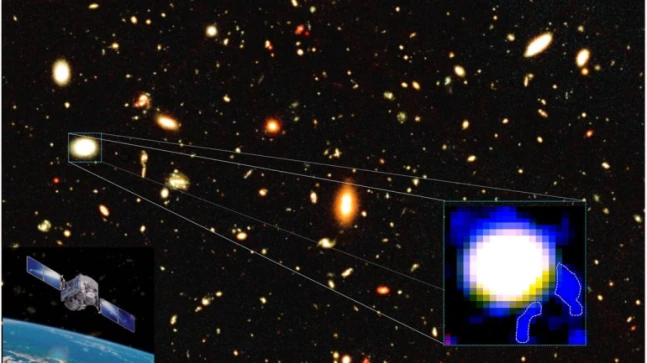Earth occupies a completely small fraction of a place withinside the Milky Way Galaxy, which itself occupies a completely small part of the universe, and notwithstanding the expansion, the Milky Way isn’t always going via new supermegacelebrity formation. However, the Milky Way is surrounded with the aid of using dwarf galaxies which are teeming with opportunities and giving delivery to stars which are packing it up.
AstroSat, India’s first devoted multi-wavelength area observatory, has now witnessed supermegacelebrity-forming complexes at the outskirts of a dwarf galaxy that migrate in the direction of the relevant place and make contributions to its increase in mass and luminosity. Astronomers have lengthy been looking to solution questions like how those dwarf and large galaxies bring together their stars and evolve into present day galaxies, like our very own galaxy.
An global crew of astronomers, along with from India, detected faint emission of Far Ultraviolet (FUV) mild withinside the outskirts of a pattern of remote Blue Compact Dwarf (BCD) galaxies which are approximately 1.5-3.nine billion mild-years away. The resolving energy of UVIT and UV deep subject imaging strategies had been the important thing to recognizing those very young, massive supermegacelebrity-forming clumps.
The take a look at has been posted withinside the magazine Nature.
Led with the aid of using Anshuman Borgohain, a Ph.D. scholar at Tezpur University, Assam, the crew calculated the time required for the clumps emigrate in the galaxy.
“Capturing the meeting method in dwarf galaxies is taken into consideration vital due to the fact the variety of their bodily homes determined these days demanding situations the cutting-edge theoretical fashions of galaxy evolution. AstroSat/UVIT has been a incredible addition to the listing of UV observatories so far and has unfolded promising home windows to probe the knowledge of the galaxy meeting method,” Anshuman stated in a declaration launched with the aid of using the Inter-University Centre for Astronomy and Astrophysics (IUCAA).
Researchers stated that the observations propose that accreting fueloline withinside the a long way outer components may be compelled to transport in the direction of the middle due to the inward torques exerted with the aid of using large fueloline and stellar complexes. This migration builds up the relevant density over the life of the galaxy.
The researchers maintained that the largest undertaking has been to firmly set up the detection of those faint, extraordinarily blue, supermegacelebrity-forming clumps which can be very a long way away to see, and at barely large distances, the UVIT could now no longer solve those galaxies. The redshift (cosmological distance) of those 12 dwarfs has been simply most beneficial to probe those blue clumpy systems of their outskirts.
“The discovery teaches us how enormously stars can shape in metal-negative fueloline disk. Normally those dwarf galaxies are ruled with the aid of using darkish count and the fueloline disk could now no longer be unstable. But our discovery is direct proof that even any such fueloline disk fragments,” Prof. Francoise Combes of Observatoire de Paris, France, co-creator of the take a look at stated.








More Stories
NASA’s Space Robots Work With Astronauts In International Space Station For The First Time
How Did Earth Become a Habitable Planet?
Why NASA’s Annoyed About Elon Musk’s Giant Rocket